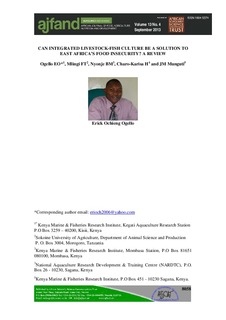| dc.description.abstract | Integrated livestock-fish culture approach envisages the integration of fish farming with cattle, sheep, goats, poultry, pigs or rabbit husbandry in a design allowing wastes from one system to be used as inputs in another system. The aim is to conserve resources while increasing farm returns. This paper reviews integrated livestock-fish culture in Asia and some African countries towards stimulating growth in East Africa’s livestock-fish integration practices. Livelihood challenges and current status of integrated livestock-fish culture in some segments of East Africa are discussed. Economic analyses of integrated livestock-fish farming in selected places are presented. Challenges facing integrated livestock-fish aquaculture in the region include: government neglect of aquaculture sector, weak aquaculture research and applications, political interferences as well as social and religious challenges. Poor publicity, poor infrastructure, lack of clear legislations and policies and high illiteracy among potential fish farmers have also been mentioned as bottlenecks to the growth of integrated fish farming in the region. So far, fish-poultry integration is the most popular across Africa and Asia while fish-cattle integration is unpopular in many countries. Livestock manure as source of organic fertilizer for fish ponds and biogas production can help reduce cost of investment in purchasing inorganic fertilizers. With the present high cost of pelleted fish feeds, integrated fish farming stands to reduce the cost of feeding fish while simultaneously increasing the yield, leading to high economic returns. This paper concludes that livestock-fish integration is one of the most practicable solutions to food insecurity and malnutrition in the East African community despite its current poor status. In fact, it could be the forgotten asset that can guarantee present and future aquaculture sustainability in the region. The paper recommends capacity building among stakeholders to recognise integrated aquaculture as a ‘self feeding’ biotechnology unit, which deserves special attention in East Africa. | nb_NO |
